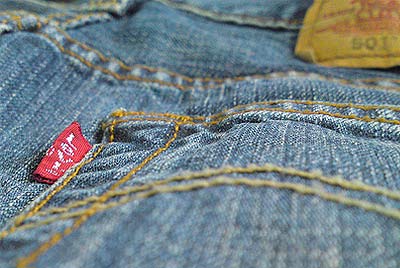 Forever in blue jeans, babe? Not anymore.Photo: bburkyMy friend Tony’s closet is as good a place as any to begin an investigation of Walmart’s environmental impact. Tony has a pair of Levi’s that date back to high school more than 20 years ago. They still fit him and they’re still in rotation. The fabric has a smooth patina that hints at its age, but, compared to another pair of Levi’s he bought only a couple of years ago, this pair actually looks far less worn. The denim is sturdier, the seams more substantial, the rivets bigger.
Forever in blue jeans, babe? Not anymore.Photo: bburkyMy friend Tony’s closet is as good a place as any to begin an investigation of Walmart’s environmental impact. Tony has a pair of Levi’s that date back to high school more than 20 years ago. They still fit him and they’re still in rotation. The fabric has a smooth patina that hints at its age, but, compared to another pair of Levi’s he bought only a couple of years ago, this pair actually looks far less worn. The denim is sturdier, the seams more substantial, the rivets bigger.
Tony’s old pair of Levi’s may well have been made in the U.S, and they likely cost more than his new pair. The new ones were manufactured abroad — Levi’s closed its last U.S. factory in 2003 — and, though Tony didn’t buy them at Walmart, their shoddy construction can be blamed at least in part on the giant retailer and the way it’s reshaping manufacturing around the world.
Since 1994, the consumer price of apparel, in real terms, has fallen by 39 percent. “It is now possible to buy clothing, long a high-priced and valuable commodity, by the pound, for prices comparable to cheap agricultural products,” notes Juliet Schor. Cheapness — and the decline in durability that has accompanied it — has triggered an astonishing increase in the amount of clothing we buy. In the mid-1990s, the average American bought 28 items of clothing a year. Today, we buy 59 items. We also throw away an average of 83 pounds of textiles per person, mostly discarded apparel, each year. That’s four times as much as we did in 1980, according to an EPA analysis of municipal waste streams [PDF].
Most consumer products have followed a similar trajectory over the last two decades. Walmart has done more than any other company to drive these changes, though other retailers have since followed its model. Where once we measured value when we shopped, Walmart trained us to see only price. Its hard bargaining pushed manufacturers offshore and drove them, year after year, to cut more corners and make shoddier products. As union-wage production jobs and family-owned businesses fell by the wayside, many Americans could no longer afford anything but Walmart’s cheap offerings.
Today Walmart says it wants to reduce the amount of pollution involved in making some of the stuff it sells. That seems like a good thing — except that everything else Walmart does is designed to undermine the durability of consumer goods, accelerate the flow of products from factory to landfill, and get us to buy more stuff. Even if Walmart does succeed in reducing the resources used to make a T-shirt or a television set, those gains will be more than outstripped by growth in the number of T-shirts and TVs we’re consuming.
The six-dollar toaster
On a recent visit to Walmart store No. 2659, just outside of Portland, Maine, I tried to find evidence of a shift to more sustainable products, but I didn’t see much beyond CFL bulbs and reusable shopping bags. There were no Seventh Generation cleaning supplies or organic cotton clothes, for example.
I did, however, spot a toaster that retails for $6.24 — a price that renders its longevity virtually irrelevant. If it breaks, just buy another.
Prices on general household goods have fallen by about one-third since the mid-1990s. Given how awash in stuff we were in those boom years, it’s shocking just how much more we buy now. Since 1995, the number of toasters and other small electro-thermal appliances sold in the U.S. each year increased from 188 million to 279 million. The average household now buys a new TV every 2.5 years, up from every 3.4 years in the early 1990s. We buy more than 2 billion bath towels a year, up from 1.4 billion in 1994. And on and on.
While there are certainly factors beyond Walmart that have contributed to this ever-expanding avalanche of consumption, the company has been a major driver of the trend. Its growth and profitability rest on fueling an ever-faster churn of products, from factory to shelf to house to landfill.
In a paper [PDF] that came out last year, three business professors illustrate how inducing manufacturers to cut product quality enhances Walmart’s competitive position. “Because lower quality products are usually cheaper to produce, it is often argued that discount retailers induce lower quality in order to drive down prices. Our model suggests, however, that the competitive and bargaining position effects provide incentives to induce lower quality regardless of changes in production costs,” the authors write.
 They don’t make ’em like they used to. Photo: Camilla CarlströmIn other words, getting manufacturers to make shoddier products doesn’t just mean that Walmart can offer super-cheap wares; it also helps Walmart marginalize its competitors and gain more dominance over its suppliers. By using its market power to drive down the quality of manufacturing, Walmart gains an advantage over department stores and independent retailers because quality (and the knowledgeable service that typically goes with it) is no longer an important factor in a consumer’s choice about where to shop. If you are going to end up with a crappy to mediocre blender anyway, then why bother spending more or availing yourself of the advice and service of a specialty retailer? Reducing the overall quality of products thus destroys a key competitive advantage of Walmart’s smaller rivals.
They don’t make ’em like they used to. Photo: Camilla CarlströmIn other words, getting manufacturers to make shoddier products doesn’t just mean that Walmart can offer super-cheap wares; it also helps Walmart marginalize its competitors and gain more dominance over its suppliers. By using its market power to drive down the quality of manufacturing, Walmart gains an advantage over department stores and independent retailers because quality (and the knowledgeable service that typically goes with it) is no longer an important factor in a consumer’s choice about where to shop. If you are going to end up with a crappy to mediocre blender anyway, then why bother spending more or availing yourself of the advice and service of a specialty retailer? Reducing the overall quality of products thus destroys a key competitive advantage of Walmart’s smaller rivals.
Even when a manufacturer responds to Walmart’s cost-cutting pressure by producing a separate, cheaper line to sell only in big-box stores — as many name-brand companies now do — the brand’s reputation for quality can suffer, making it hard for specialty retailers to persuade customers that the higher-quality, longer-lasting versions they offer are worth more.
As local stores and other competing retailers are weakened, manufacturers become more dependent on Walmart. Many major consumer products companies now rely on Walmart for one-quarter or more of their business. According to the study, this gives the chain greater bargaining power over its suppliers, who have fewer options for bringing their wares to market and thus little leverage to resist the retailer’s demands.
Walmart is also a master at getting shoppers to buy more than they came for. It employs all of the techniques that have been shown to spur “unplanned buying,” according to a recent study [PDF] in the Journal of Marketing. The study found that large stores that promote the concept of one-stop shopping and can only be reached by car generate the most impulse buys. Marketing messages that evoke abstract shopping goals are also highly effective at inducing people to put more stuff in their carts. The authors cite Walmart’s “Save Money, Live Better” slogan as a leading example.
According to the study, the least amount of unplanned buying occurs when a shopping trip involves multiple stores, each with a specific product focus, and the customer arrives on foot or by mass transit — in other words, when you shop at small neighborhood and downtown retailers.
A low-tar cigarette
Walmart has a powerful incentive to increase the scale of consumption. Sustainability will never be more than a modest sideshow to this larger endeavor. Nowhere in Walmart’s pronouncements about greening its supply chain does the company mention the durability of products or the pace at which households burn through the stuff its stores sell.
As consumers, we’re hardly innocent in all of this, of course. With prices falling below the real human and environmental costs of production, we have been happy to upgrade to a bigger TV or buy four T-shirts when one would suffice. But imagining that Walmart might be part of the cure is like putting tobacco companies in charge of ending smoking. Walmart’s sustainability plan is the low-tar cigarette of the environmental movement: it admits there’s a problem, but offers a kind of pseudo solution that’s really aimed at keeping us all puffing.
As Walmart takes over an ever-larger share of the global economy, companies that favor a more durable and sustainable model of production are squeezed to the margins. The business press is replete with tales of storied U.S. brands, like Levi’s, which held out against Walmart for years before finally giving in, moving overseas, and figuring out how to make a $10 pair of jeans. Some still resist. Stihl, for example, the world’s leading maker of chain saws, has been vocal about retaining the quality of its products by not selling to the big boxes. But if Walmart and those that follow its model continue to grow, there may soon come a day when no producer can escape its dictates.
Next up: How is Walmart really doing on renewables?




